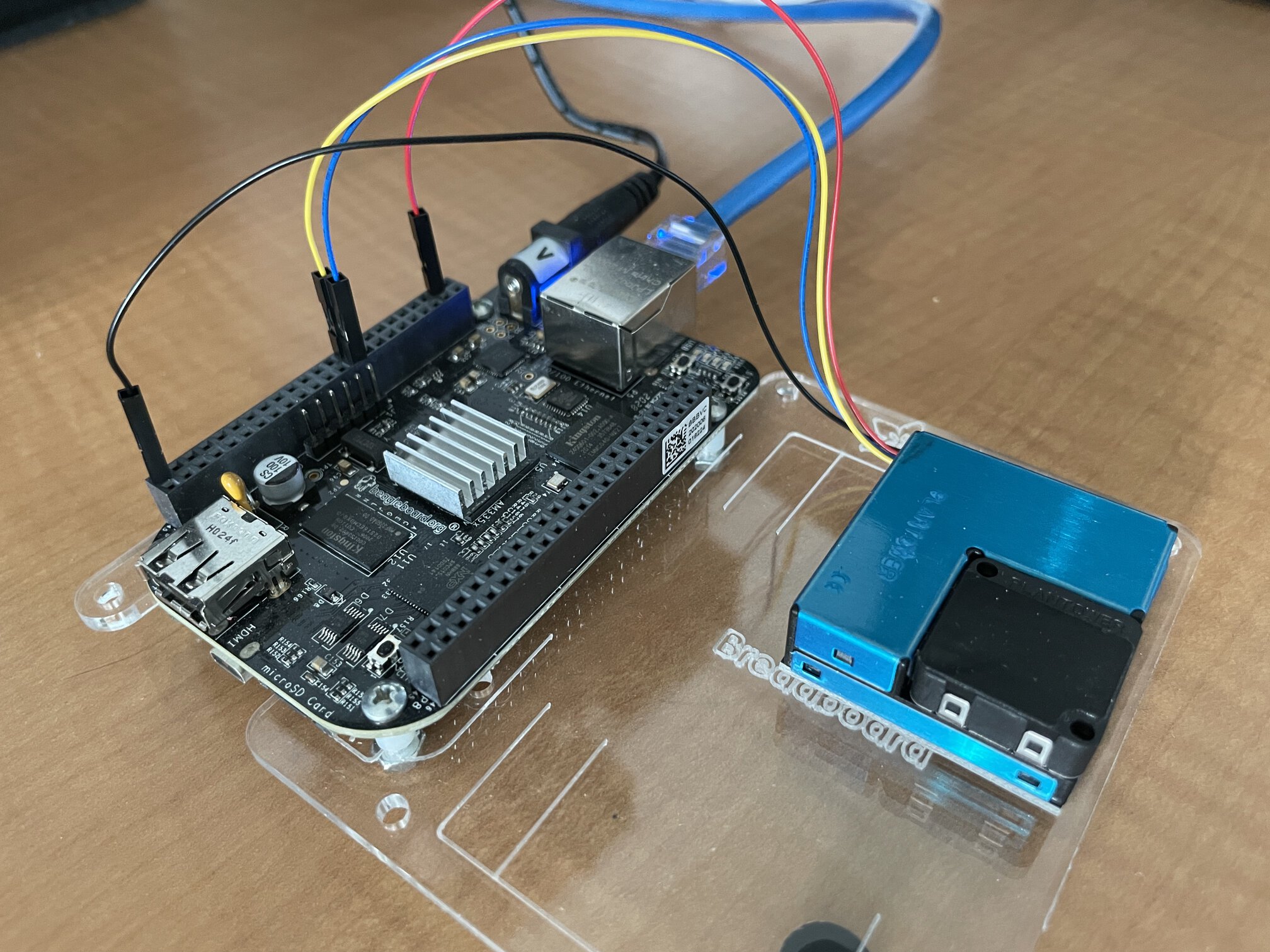The Adafruit PMSA003I Air Quality Breakout is a sensor that measures and reports the amount of particulates in ambient air. This Plantower PMSA003I sensor is essentially the same devices used in PurpleAir sensors which are indispensible during California's wildfire season.
This Adafruit PMSA003I exposes its readings via I2C interface, but it is not very well documented outside of the Adafruit libraries that support it. It also took me a while to figure out how the readings from this sensor relate to the AQI reported by PurpleAir. What follows are my notes on how all of this works.
Getting Started - Beaglebone
The physical wireup for this sensor to a Beaglebone Black is simple. I used the Qwiic connector and a Qwiic JST SH 4-pin to male header cable to plug directly into the Beaglebone Black P9 header:
- Black (Ground) to P9_45 (but any ground pin will work)
- Red (3.3V) to P9_3
- Yellow (I2C SCL) to P9_19 which is I2C bus 2's SCL
- Blue (I2C SDA) to P9_20 which is I2C bus 2's SDA

The easiest way to verify that I2C is wired up and the sensor is working is to
use the Adafruit Python drivers which work fine on Beaglebone. Make sure you
have python3-venv installed via apt, then
$ python3 -mvenv adafruit
$ . adafruit/bin/activate
(adafruit) $ pip install adafruit-blinka
(adafruit) $ pip install adafruit_bbio
(adafruit) $ pip install https://files.pythonhosted.org/packages/6d/b8/15436b3d9925ed29aeb8f67c1b18b708f37c95e2b4106da8c9585c9d810c/adafruit-circuitpython-pm25-2.1.4.tar.gz
To verify that the sensor works, use the example library bundled with the adafruit-circuitpython-pm25 library:
(adafruit) $ wget https://raw.githubusercontent.com/adafruit/Adafruit_CircuitPython_PM25/main/examples/pm25_simpletest.py
(adafruit) $ python3 pm25_simpletest.py
Reading via I2C
The PMSA300I datasheet documents how to interpret the contents of the I2C
registers, but i2cdump only gave me 0x42 for all register values. Stay tuned
for more information on how to interact with this sensor directly through I2C.
Interpreting sensor readings
The sensor exposes the following measurements via I2C:
- PM1.0 concentration in units of micrograms per cubic meter (μg/m3) - standard (CF=1) version
- PM2.5 concentration in μg/m3 - standard (CF=1) version
- PM10 concentration in μg/m3 - standard (CF=1) version
- PM1.0 concentration in μg/m3 - environmental (CF=atm) version
- PM2.5 concentration in μg/m3 - environmental (CF=atm) version
- PM10 concentration in μg/m3 - environmental (CF=atm) version
- Number of particles of size > 0.3 microns in units of particles per decileter
- Number of particles of size > 0.5 microns in units of particles per decileter
- Number of particles of size > 1.0 microns in units of particles per decileter
- Number of particles of size > 2.5 microns in units of particles per decileter
- Number of particles of size > 5.0 microns in units of particles per decileter
- Number of particles of size > 10 microns in units of particles per decileter
This all sounds great, but what does it mean? I noticed two big mysteries immediately:
- I don't know what "standard particle" or "atmospheric environment" means in the context of the PM2.5 measurements.
- None of these are AQI! How do I get an AQI from these?
Standard PM vs. Environment PM
Nobody seems to know what the difference between these two measurements are. There are only two hints as to which one to use.
The PMSA300I datasheet simply says "CF = 1 should be used in the factory environment" which suggests it is only meant to be used for factory calibration and the atmospheric environment metrics are the ones we should use in real life.
However a number of slides presented by researchers at the US Environmental Protection Agency used the standard particle reading despite the datasheet and point out that it is consistently lower than the atmospheric environment reading. They point out that PurpleAir uses the CF=1 for indoor sensors and CF=atm for outdoor sensors, but I get the impression that nobody but the Plantower folks who manufacture this sensor really know.
Calculating AQI
AQI is a mysterious metric because it is unitless, not well-defined mathematically, and has different mathematical definitions in different countries (and even the same country at different times!). In the USA, the EPA defines the AQI using a set of linear functions that each correspond to one of eight ranges of unhealthiness. These eight ranges are defined using "breakpoints," and for example, the EPA defines the breakpoints for the PM2.5 AQI as follows:
| AQI Category | Lower AQI | Upper AQI | Low Breakpoint | High Breakpoint |
|---|---|---|---|---|
| Good | 0 | 50 | 0.0 | 12.0 |
| Moderate | 51 | 100 | 12.1 | 35.4 |
| Unhealthy for sensitive | 101 | 150 | 35.5 | 55.4 |
| Unhealthy | 151 | 200 | 55.5 | 150.4 |
| Very unhealthy | 201 | 300 | 150.5 | 250.4 |
| Hazardous | 301 | 400 | 250.5 | 350.4 |
| Hazardous | 401 | 500 | 350.5 | 500.4 |
| Hazardous | 501 | 999 | 500.5 | 99999.9 |
These are up-to-date as of August 2021 and are ripped straight from the EPA AQI breakpoints page. The formula is
$ {AQI}(C) = \frac{ {AQI}_{high} - {AQI}_{low} } { {Breakpoint}_{high} - {Breakpoint}_{low} } (C - C_{low}) + {AQI}_{low} $
where $ C $ is the observed PM2.5 concentration from the sensor (either CF=1 or CF=atm; your choice) and the other values come from the AQI breakpoints table.
It's probably easier to illustrate how to calculate the AQI in Python. For
example, calculating the PM2.5 AQI from the PM2.5 concentration (conc) looks
something like this:
AQI_BREAKPOINTS = [
( 50, 12.0),
(100, 35.4),
(150, 55.4),
(200, 150.4),
(300, 250.4),
(400, 350.4),
(500, 500.4),
(999, 99999.9),
]
def calculate_aqi(conc):
breakp_low, conc_low = (0, 0.0)
for breakp_hi, conc_hi in AQI_BREAKPOINTS:
if breakp_hi is None or conc <= conc_hi:
break
breakp_low, conc_low = (breakp_hi, conc_hi)
aqi = (conc - conc_low) / (conc_hi - conc_low) * (breakp_hi - breakp_low) + breakp_low
return aqi